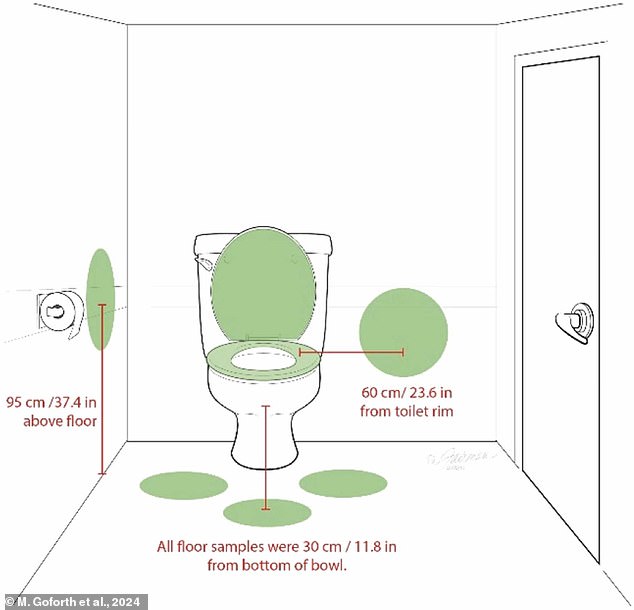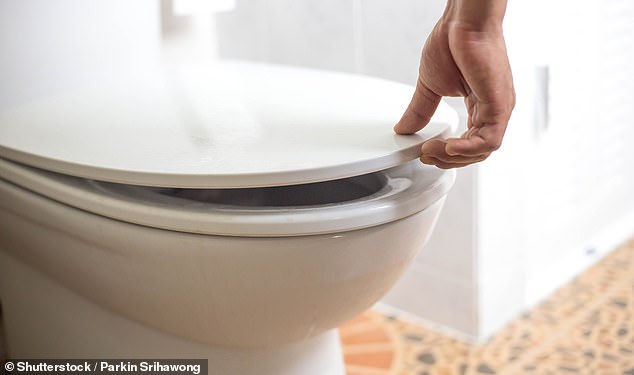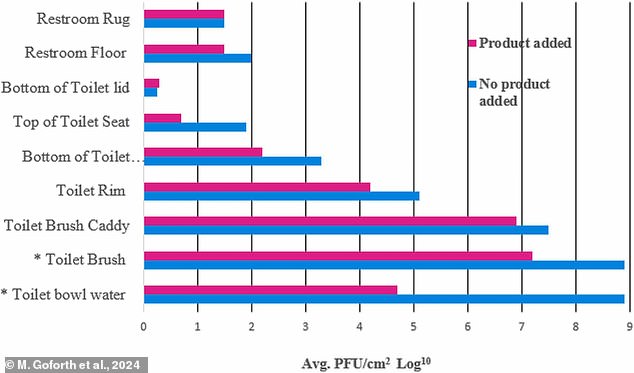Will flushing with the lid down stop your bathroom being peppered with the dreaded ‘toilet plume’? Scientists test age-old theory and make a very surprising discovery
Flushing the toilet can be a lot rougher than you expected.
According to scientists, flushing emits ‘toilet plumes’ of tiny droplets that spread through the air to every surface of the bathroom.
But can closing the lid protect you from this spray?
Unfortunately, scientists at the University of Arizona say it actually makes no difference whether the lid is up or down.
Instead, regularly cleaning the bowl with a disinfectant can eliminate the worst bacteria and make flushing safe no matter where the lid is located, they say.
Scientists say rinsing can release a plume of aerosolized bacteria and viruses into the air. But is it better to leave the lid open or closed while rinsing?
Since the 1950s, it has been common knowledge that flushing the toilet leads to an explosion of feces, toilet water, and whatever else is in the bowl.
But this also applies to material you can’t see, because scientists say that ‘toilet plumes’ contain droplets so small that they form an invisible aerosol mist.
Previous studies from the University of Colorado used green light and lasers to show that these plumes can fly 5 feet above the toilet in eight seconds.
More worryingly, these aerosols can drift through air currents and carry bacteria and viruses throughout the bathroom, covering surfaces and people present.
This can lead to the spread of diseases such as E. Coli, norovirus and even Covid 19.
Due to the risk of infection this poses, especially in hospital wards or for people with weakened immune systems, prevailing wisdom recommends closing the lid to collect the spray.
But as the researchers emphasize in their article, this has no substantial scientific basis.
They say in their article published in the American Journal of Infection Control: ‘The potential benefit of closing the toilet lid during flushing for reducing viral contamination of toilet surfaces has not been empirically demonstrated.’

Researchers seeded a toilet with MS2 bacteria, a model for E. Coli, and took samples from the areas around the toilet one minute after flushing
To find out more, the researchers littered a public and private toilet with samples of MS2 bacteria as a model for E. Coli.
The toilets were then flushed and after a minute samples were taken from various surfaces in the bathroom.
These samples were then transferred to the laboratory and studied to see how contaminated they had become.
What was surprising was that there was no statistically significant difference between closing the lid or not.
The researchers found that samples taken around the toilet appeared to be equally contaminated with MS2 regardless of whether the lid was up or down.
Instead, the researchers found evidence that closing the lid likely changed the plume’s trajectory: down toward the floor instead of straight up into the air.
Overall, the toilet seat was the most soiled area, both at the top and bottom, followed by the floor around the toilet and the walls on either side.
However, the toilet lid itself seemed to stay strangely clean.

Surprisingly, the researchers found that leaving the lid open or closed made no statistically significant difference to the spread of bacteria in the bathroom.
The researchers wrote: ‘Surprisingly, MS2 contamination of the bottom or top of the toilet lid was consistently low, regardless of the position of the lid prior to flushing.’
The public toilets in the study, which do not have a lid to close, were consistently found to be more polluted than the household toilet.
But the researchers suggest this is likely due to the higher water flow into the toilet bowl during the flushing of public toilets.
But there’s still no reason to be afraid to flush your toilet, because researchers think there is a solution.
The scientists tested how bacteria spread during routine toilet cleaning, with and without the use of disinfectant.
They found that cleaning with the brush alone spread MS2 bacteria to the brush, the toilet brush holder and parts of the surrounding area.
But vigorous brushing and adding disinfectant reduced toilet water contamination by 99.99 percent compared to brushing alone.
Adding Lysol disinfectant to the bowl before flushing also made a statistically significant reduction in the contamination of the brush used to clean the toilet.
While the disinfectant didn’t prevent the cleaning from spreading some aerosolized bacteria into the bathroom, it did significantly reduce the amount of bacteria left in the bowl.

But as this graph shows, adding disinfectant to the toilet bowl while cleaning led to a significant reduction in the amount of bacteria in the toilet bowl. It is important to note that the scale in this graph is logarithmic rather than linear, which may make the differences appear less significant than they actually are.
This is important because the researchers note that bacteria can linger in the toilet even after several flushes.
For example, if you share a bathroom with someone who has norovirus, you can become infected with the disease by flushing, even if you don’t go to the toilet right after them.
But given the significant effect of disinfectants on the number of bacteria in water, the researchers say that regularly disinfecting the toilet is the best way to minimize this risk.
Using disinfectants is especially important if a household member has a compromised immune system.
Although the researchers note that the contamination levels found in this study were relatively low, they argue that this shows that flushing is a potential route of infection.
They therefore recommend ‘regular disinfection of all toilet surfaces after cleaning the toilet, and/or the use of a disinfectant that leaves residual microbial activity.
‘Especially if the household is occupied by a person with an active infection with a virus, such as norovirus, which causes acute gastroenteritis.’
